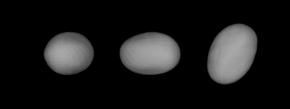
Back 283 Emma (كويكب) ARZ (283) Emma Catalan (283) Эмма CE (283) Emma German 283 Έμμα Greek 283 Emma Esperanto (283) Emma Spanish 283 Emma Basque اما ۲۸۳ Persian (283) Emma French
 A three-dimensional model of 283 Emma based on its light curve | |
| Discovery | |
|---|---|
| Discovered by | Auguste Charlois |
| Discovery date | 8 February 1889 |
| Designations | |
| (283) Emma | |
| Pronunciation | /ˈɛmə/[1] |
| A889 CA, 1980 FJ12 | |
| Main belt (Emma) | |
| Orbital characteristics[2] | |
| Epoch 31 July 2016 (JD 2457600.5) | |
| Uncertainty parameter 0 | |
| Observation arc | 122.26 yr (44655 d) |
| Aphelion | 3.49701 AU (523.145 Gm) |
| Perihelion | 2.59675 AU (388.468 Gm) |
| 3.04688 AU (455.807 Gm) | |
| Eccentricity | 0.14773 |
| 5.32 yr (1942.6 d) | |
Average orbital speed | 17.07 km/s |
| 127.107° | |
| 0° 11m 7.148s / day | |
| Inclination | 7.99162° |
| 304.369° | |
| 53.7020° | |
| Known satellites | 1 (9±5 km)[3] |
| Physical characteristics | |
| Dimensions | 148.06±4.6 km (IRAS)[2] 160±10 km (AO)[3] |
| Mass | 1.38×1018 kg[4] |
Mean density | 0.81±0.08 g/cm3[4] |
| 6.896 h (0.2873 d)[2] | |
| 0.0262±0.002[2] (Dark) | |
| 8.72[2] | |
283 Emma is a large asteroid of the asteroid belt and the namesake of the Emma family. It was discovered by Auguste Charlois on 8 February 1889, in Nice, France. The reason for its name is unknown.[5]
Measurements made with the IRAS observatory give a diameter of 145.70±5.89 km and a geometric albedo of 0.03±0.01. By comparison, the MIPS photometer on the Spitzer Space Telescope gives a diameter of 145.44±7.72 km and a geometric albedo of 0.03±0.01. When the asteroid was observed occulting a star, the results showed a diameter of 148.00±16.26 km.[6]
- ^ "Emma". Dictionary.com Unabridged (Online). n.d.
- ^ a b c d e Cite error: The named reference
jpldatawas invoked but never defined (see the help page). - ^ a b Cite error: The named reference
Marchis2008was invoked but never defined (see the help page). - ^ a b Jim Baer (12 December 2010). "Recent Asteroid Mass Determinations". Personal Website. Archived from the original on 29 January 2009. Retrieved 17 July 2015.
- ^ Lutz D. Schmadel (2003). Dictionary of Minor Planet Names (5th ed.). Springer Science & Business Media. p. 40. ISBN 978-3-540-00238-3.
- ^ Cite error: The named reference
2012arXiv1204was invoked but never defined (see the help page).